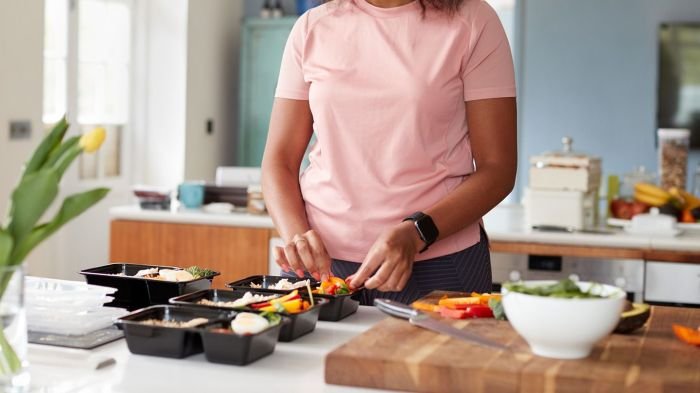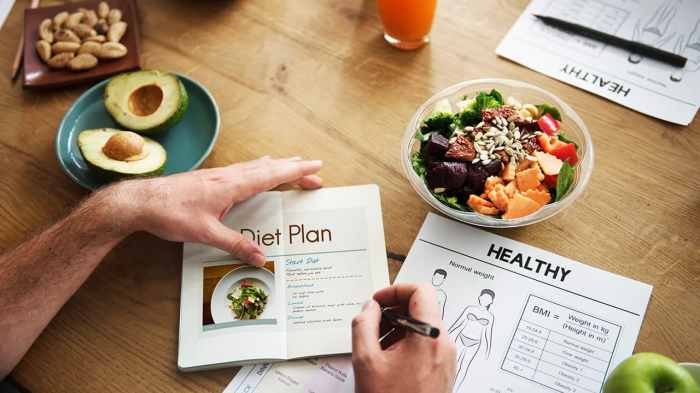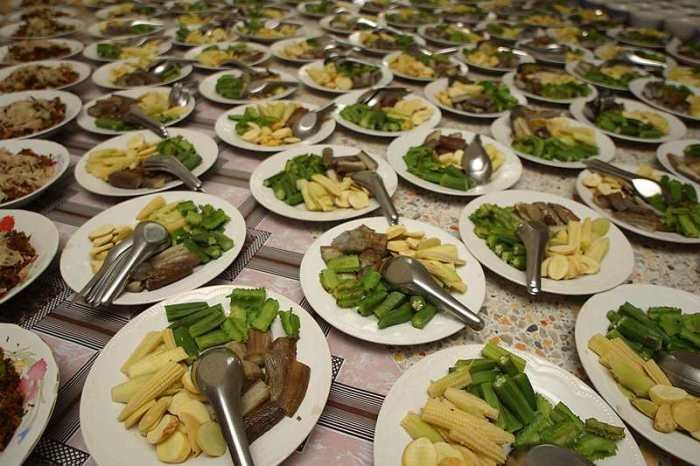Health prep meals are a game-changer for those seeking to prioritize their well-being. This strategic approach involves preparing healthy meals in advance, empowering you to make conscious food choices throughout the week. By investing a few hours in meal prepping, you can save time, money, and ultimately, your health.
Meal prepping offers numerous advantages, including promoting healthier eating habits, reducing impulsive food choices, and fostering a sense of control over your diet. It allows you to enjoy delicious and nutritious meals without the stress of last-minute cooking, ensuring that you consistently nourish your body with the right ingredients.
What are Health Prep Meals?

Health prep meals are pre-prepared meals designed to promote healthy eating habits. These meals are often made in advance and stored for later consumption, providing a convenient and nutritious way to fuel your body.Preparing healthy meals in advance offers numerous benefits, including:
Benefits of Health Prep Meals
Preparing healthy meals in advance offers a number of advantages:
- Time-saving:By dedicating a few hours to meal prep, you can save time during the week, avoiding the need to cook every night.
- Cost-effective:Meal prepping allows you to buy ingredients in bulk, often at lower prices. It also helps prevent impulse purchases of unhealthy takeout.
- Healthy Eating:Meal prepping encourages you to focus on preparing nutritious meals with fresh ingredients. It can help you avoid processed foods and sugary snacks.
- Portion Control:By preparing your meals in advance, you can control portion sizes, preventing overeating and promoting healthy weight management.
- Increased Flexibility:Having pre-prepared meals on hand provides flexibility for busy schedules. You can easily grab a healthy meal and go, reducing the temptation to eat unhealthy options.
Meal Prepping vs. Traditional Cooking
Meal prepping differs from traditional cooking in several ways:
- Time Commitment:Meal prepping involves a larger upfront time commitment, but it saves time during the week. Traditional cooking requires cooking each meal individually.
- Cooking Style:Meal prepping often involves cooking larger batches of food, while traditional cooking focuses on preparing individual meals.
- Focus:Meal prepping emphasizes planning and preparation, while traditional cooking allows for spontaneity and improvisation.
Planning Your Health Prep Meals

Planning your health prep meals is an essential step towards a healthier lifestyle. By taking the time to organize your meals in advance, you can ensure you have nutritious and delicious food readily available throughout the week, saving you time and money while promoting healthy eating habits.
Creating a Weekly Meal Prep Schedule
A weekly meal prep schedule helps you plan your meals and grocery shopping, ensuring you have all the ingredients you need on hand.
Health prep meals can be a lifesaver for busy individuals, especially those working in demanding fields like healthcare. For example, psych mental health NP jobs often require long hours and irregular schedules, making it difficult to consistently cook healthy meals.
Having pre-prepared meals on hand can help ensure that these professionals are fueling their bodies with the nutrients they need to perform at their best, both physically and mentally.
- Identify your goals:Determine your meal prep goals. Are you aiming to eat healthier, save time, or reduce food waste? Clearly defining your goals will help you tailor your meal prep schedule accordingly.
- Choose your meals:Select a variety of meals you enjoy and that align with your dietary needs and preferences. Consider incorporating different protein sources, vegetables, and healthy fats for a balanced diet.
- Create a shopping list:Based on your chosen meals, create a comprehensive grocery list. Include all the ingredients you need, ensuring you have enough for each meal and any snacks you might need.
- Allocate time:Set aside specific time slots for meal prepping. You can dedicate a few hours on a weekend or spread it out throughout the week. Be realistic about how much time you can commit to meal prep.
- Schedule your meals:Decide when you will eat your prepared meals. This helps you stay organized and ensures you have healthy options available when you need them.
Selecting Healthy and Nutritious Ingredients
Choosing healthy and nutritious ingredients is crucial for meal prepping. Here are some tips:
- Prioritize whole foods:Focus on whole, unprocessed foods like fruits, vegetables, whole grains, lean proteins, and healthy fats. These foods are rich in nutrients and provide lasting energy.
- Read food labels:Pay attention to serving sizes, calories, and macronutrient content. Look for options low in added sugars, saturated fats, and sodium.
- Choose lean protein sources:Opt for lean protein sources like chicken breast, fish, tofu, beans, and lentils. These provide essential amino acids for muscle growth and repair.
- Incorporate plenty of vegetables:Aim to include a variety of colorful vegetables in your meals. They are packed with vitamins, minerals, and fiber.
- Choose healthy fats:Include sources of healthy fats like avocados, nuts, seeds, and olive oil. These fats are beneficial for heart health and overall well-being.
Managing Time and Resources Effectively, Health prep meals
Effective time and resource management is essential for successful meal prepping.
Health prep meals are a fantastic way to stay on track with your wellness goals. They can be a lifesaver when you’re short on time, but it’s crucial to ensure they’re packed with nutritious ingredients. For some inspiration on creating delicious and healthy meals, check out health tis for some creative and tasty recipe ideas.
With a little planning, you can easily incorporate health prep meals into your busy schedule and enjoy the benefits of a balanced diet.
- Batch cooking:Prepare multiple servings of the same dish at once. This saves time and effort, allowing you to have multiple meals ready to go.
- Utilize leftovers:Plan your meals to use leftovers creatively. This minimizes food waste and adds variety to your meals.
- Invest in time-saving tools:Consider using a slow cooker, pressure cooker, or food processor to simplify meal prep. These appliances can significantly reduce cooking time.
- Don’t be afraid to simplify:Keep your meal prep simple and manageable. Choose recipes that are easy to prepare and don’t require too many ingredients.
- Plan for storage:Have containers ready for storing your prepared meals. Use airtight containers to keep food fresh and prevent spills.
Recipes and Meal Ideas

Meal prepping can be a fun and creative process! It’s a chance to experiment with different flavors and ingredients, and to create healthy and delicious meals that you can enjoy throughout the week.
Recipe Ideas
This table showcases a diverse selection of healthy meal prep recipes, providing inspiration for your weekly meal planning.
| Recipe Name | Ingredients | Preparation | Nutritional Information |
|---|---|---|---|
| Chicken Fajita Bowls | Chicken breast, bell peppers, onions, fajita seasoning, brown rice, black beans, salsa, avocado | Marinate chicken with fajita seasoning, then cook with peppers and onions. Serve over rice with black beans, salsa, and avocado. | High in protein, fiber, and vitamins. |
| Quinoa Salad with Roasted Vegetables | Quinoa, broccoli, carrots, sweet potatoes, olive oil, salt, pepper, lemon juice | Roast vegetables with olive oil, salt, and pepper. Combine with cooked quinoa and toss with lemon juice. | A good source of complex carbohydrates, fiber, and antioxidants. |
| Salmon with Roasted Asparagus and Lemon | Salmon fillets, asparagus, lemon, olive oil, salt, pepper | Roast asparagus with olive oil, salt, and pepper. Grill or bake salmon with lemon slices and season with salt and pepper. | Rich in omega-3 fatty acids, protein, and vitamins. |
| Lentil Soup | Lentils, vegetable broth, carrots, celery, onions, garlic, tomato paste, spices | Sauté onions, celery, and carrots. Add lentils, broth, tomato paste, and spices. Simmer until lentils are tender. | A hearty and filling meal that is high in protein, fiber, and iron. |
Healthy Meal Prep Ideas
Meal prepping can be tailored to your individual needs and preferences. Here are some ideas for breakfast, lunch, and dinner:
Breakfast
- Overnight oats: Combine rolled oats, milk, yogurt, and your favorite toppings (fruit, nuts, seeds) in a jar. Refrigerate overnight and enjoy in the morning.
- Smoothies: Blend fruits, vegetables, yogurt, protein powder, and other ingredients for a quick and nutritious breakfast.
- Egg muffins: Whisk eggs with vegetables and cheese, pour into muffin tins, and bake until set. These can be reheated in the microwave or oven.
Lunch
- Salad bowls: Combine greens, protein (chicken, fish, beans), vegetables, and a light dressing.
- Soup and sandwiches: Prepare a large batch of soup and pair it with whole-grain bread and your favorite fillings.
- Leftovers: Use leftovers from dinner for a quick and easy lunch.
Dinner
- Sheet pan meals: Roast vegetables and protein on a single sheet pan for a simple and healthy dinner.
- One-pot meals: Cook everything in one pot for a convenient and flavorful dinner.
- Slow cooker meals: Use a slow cooker to prepare hearty and comforting meals that are perfect for meal prepping.
Storage and Preservation

Proper storage and preservation are crucial for maximizing the shelf life of your prepped meals and ensuring their safety and quality. By following best practices, you can enjoy your healthy meals for longer while maintaining their nutritional value and flavor.
Containers
The type of container you choose plays a significant role in preserving the quality of your prepped meals.
- Glass containersare generally considered the best option for storing prepped meals. They are durable, reusable, and do not leach harmful chemicals into your food. Glass containers are also microwave-safe and oven-safe, making them versatile for reheating and serving.
- Plastic containersare a convenient and affordable alternative to glass. However, it’s essential to choose BPA-free plastic containers to avoid potential health risks. Ensure the containers are microwave-safe if you plan to reheat your meals in them.
- Silicone containersare another good option for storing prepped meals. They are flexible, leak-proof, and can withstand high temperatures. Silicone containers are also a great choice for freezing meals.
Labeling
Proper labeling is essential for keeping track of your prepped meals.
- Date: Label each container with the date the meal was prepared. This helps you rotate your meals and ensure you consume the freshest ones first.
- Meal name: Label each container with the name of the meal, making it easier to identify and choose what you want to eat.
- Ingredients: For meals containing allergens, clearly label the container with a list of ingredients to prevent potential allergic reactions.
Refrigeration Techniques
Refrigeration is key to keeping your prepped meals fresh and safe to eat.
- Temperature: Keep your refrigerator at a temperature of 40°F (4°C) or lower. This temperature range is ideal for slowing down bacterial growth and preserving the quality of your meals.
- Placement: Store prepped meals on the shelves of your refrigerator, not in the door, as the temperature in the door fluctuates more.
- Stacking: Stack containers neatly to maximize space and prevent crushing or damaging the meals.
Shelf Life of Prepped Meals
The shelf life of prepped meals varies depending on the ingredients and preparation method.
Health prep meals are a fantastic way to ensure you’re getting nutritious food even on busy days. But don’t forget about your skin! Miche Beauty offers a range of natural skincare products that can help you achieve a healthy glow, complementing your healthy eating habits.
By taking care of both your inner and outer health, you can truly feel your best!
- Cooked grains and legumes: 3-4 days in the refrigerator.
- Cooked vegetables: 3-4 days in the refrigerator.
- Cooked proteins: 3-4 days in the refrigerator.
- Salads and dressings: 3-4 days in the refrigerator.
- Soups and stews: 3-4 days in the refrigerator.
- Smoothies and juices: 1-2 days in the refrigerator.
Tips for Success

Meal prepping can be a fantastic way to eat healthier and save time, but staying motivated and consistent can be challenging. This section will provide you with practical tips to make meal prepping a sustainable part of your life, preventing fatigue and making the process enjoyable.
Staying Motivated and Consistent
Staying motivated and consistent with meal prepping requires a proactive approach. Here are some strategies to help you stick with your meal prep goals:
- Set Realistic Goals:Starting small is key. Instead of prepping for the entire week, begin by prepping for a couple of days. As you become more comfortable, gradually increase your prep time.
- Choose Recipes You Enjoy:The key to sticking with meal prepping is to enjoy the food you’re preparing. Don’t be afraid to experiment with new recipes and find dishes that appeal to your taste buds.
- Plan Ahead:Take time to plan your meals for the week. This will help you stay organized and ensure you have all the necessary ingredients on hand.
- Make It a Social Activity:Invite a friend or family member to join you for meal prep. This can make the process more enjoyable and help you stay accountable.
- Reward Yourself:Celebrate your meal prepping successes! Treat yourself to a healthy meal out or a new piece of workout gear.
Preventing Meal Prep Fatigue
Meal prep fatigue can set in if you’re not careful. To prevent this, consider these tips:
- Vary Your Recipes:Avoid monotony by rotating your meal prep recipes. Experiment with different cuisines, flavors, and cooking methods to keep things interesting.
- Batch Cook:Instead of prepping individual meals, batch cook larger quantities of ingredients that can be used in multiple dishes. This saves time and effort.
- Don’t Be Afraid to Take Breaks:If you feel overwhelmed, take a break from meal prepping. There’s no need to prep meals every week. You can also consider using pre-made ingredients or frozen meals occasionally.
- Focus on Quality, Not Quantity:It’s more important to prep meals that you enjoy and will actually eat than to prep a large quantity of food that goes to waste.
Making Meal Prepping Enjoyable and Efficient
Meal prepping doesn’t have to be a chore. Here are some ways to make it more enjoyable and efficient:
- Listen to Music or Podcasts:Turn meal prep into a relaxing activity by listening to your favorite music or podcasts.
- Make It a Social Activity:Invite friends or family members over to help you prep meals. This can make the process more fun and social.
- Use Time-Saving Tools:Invest in kitchen tools that can make meal prepping easier, such as a food processor, slow cooker, or Instant Pot.
- Prepare Ingredients in Advance:Wash and chop vegetables, measure out spices, and prepare any other ingredients in advance to save time during the actual cooking process.
- Clean as You Go:Don’t let dishes pile up. Wash and put away items as you finish using them.
Concluding Remarks
Embracing health prep meals is a rewarding journey that unlocks a world of convenience, culinary creativity, and mindful eating. Whether you’re a seasoned chef or a novice in the kitchen, the principles of meal prepping can be adapted to suit your individual needs and preferences.
By planning ahead, selecting wholesome ingredients, and embracing a little culinary adventure, you can embark on a path toward a healthier, more fulfilling lifestyle.
Detailed FAQs
How often should I meal prep?
The frequency of meal prepping depends on your lifestyle and preferences. Some people prep once a week, while others prefer to do it every few days. Experiment to find a schedule that works best for you.
What if I don’t like the food I prepped?
Don’t be afraid to experiment with different recipes and ingredients. If you don’t enjoy something, you can always adjust your meal plan for the next week.
Is meal prepping expensive?
Meal prepping can be budget-friendly if you plan your meals and grocery shop strategically. Look for sales, use coupons, and consider buying in bulk.
What are some quick and easy meal prep ideas?
Some simple meal prep ideas include salads with protein, overnight oats, hard-boiled eggs, and pre-cut vegetables for snacking.